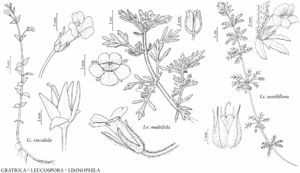Difference between revisions of "Limnophila sessiliflora"
Bijdr. Fl. Ned. Ind. 14: 749. 1826.
FNA>Volume Importer |
FNA>Volume Importer |
||
| Line 33: | Line 33: | ||
|elevation=0–500 m. | |elevation=0–500 m. | ||
|distribution=Calif.;Fla.;Ga.;La.;Tex.;Asia. | |distribution=Calif.;Fla.;Ga.;La.;Tex.;Asia. | ||
| − | |discussion=<p>Bentham (in N. Wallich 1828[–1849]) seems to have been the first to correct the spelling by Blume from sessiflora to sessiliflora, and later works have generally accepted the corrected epithet. Some works treat Hottonia sessiliflora Vahl as the basionym, but no homotypy has been established between the two names.</p><!-- | + | |discussion=<p>Bentham (in N. Wallich 1828[–1849]) seems to have been the first to correct the spelling by Blume from sessiflora to sessiliflora, and later works have generally accepted the corrected epithet. Some works treat <i>Hottonia</i> sessiliflora Vahl as the basionym, but no homotypy has been established between the two names.</p><!-- |
| − | --><p>Limnophila sessiliflora is the more common species of the genus found in North America. It is a problematic weed in rice fields and shallow ponds worldwide; it has been placed on the Federal Noxious Weed List (http://www.aphis.usda.gov/plant_health/plant_pest_info/weeds/downloads/weedlist.pdf). It is also sometimes sold in the aquarium trade under the name L. indica.</p><!-- | + | --><p><i>Limnophila sessiliflora</i> is the more common species of the genus found in North America. It is a problematic weed in rice fields and shallow ponds worldwide; it has been placed on the Federal Noxious Weed List (http://www.aphis.usda.gov/plant_health/plant_pest_info/weeds/downloads/weedlist.pdf). It is also sometimes sold in the aquarium trade under the name <i>L. indica</i>.</p><!-- |
| − | --><p>An uncommon hybrid with Limnophila indica (L. ×ludoviciana Thieret) is distinguished by its ebracteolate pedicels 5–10 mm and calyx lobes 1–2 mm with eglandular trichomes (D. Philcox 1970). Some of the plants identified as the hybrid are actually L. sessiliflora with pedicellate flowers, a condition found throughout the range of the species.</p> | + | --><p>An uncommon hybrid with <i>Limnophila indica</i> (L. ×ludoviciana Thieret) is distinguished by its ebracteolate pedicels 5–10 mm and calyx lobes 1–2 mm with eglandular trichomes (D. Philcox 1970). Some of the plants identified as the hybrid are actually <i>L. sessiliflora</i> with pedicellate flowers, a condition found throughout the range of the species.</p> |
|tables= | |tables= | ||
|references= | |references= | ||
| Line 60: | Line 60: | ||
|publication year=1826 | |publication year=1826 | ||
|special status=Weedy;Introduced;Selected by author to be illustrated | |special status=Weedy;Introduced;Selected by author to be illustrated | ||
| − | |source xml=https://jpend@bitbucket.org/aafc-mbb/fna-data-curation.git/src/ | + | |source xml=https://jpend@bitbucket.org/aafc-mbb/fna-data-curation.git/src/8f726806613d60c220dc4493de13607dd3150896/coarse_grained_fna_xml/V17/V17_657.xml |
|genus=Limnophila | |genus=Limnophila | ||
|species=Limnophila sessiliflora | |species=Limnophila sessiliflora | ||
Revision as of 16:02, 18 September 2019
Perennials aquatic. Stems: submerged glabrous, aerial to 20 cm, glabrous or pubescent with eglandular and glandular hairs. Leaves opposite; blade of submerged leaves ovate to broadly ovate in outline, 10–35 × 10–15 mm, segments flattened or capillary, blade of aerial leaves elliptic to lanceolate, 10–30(–80) × 2–5(–10) mm. Inflorescences axillary, flowers solitary, rarely paired. Pedicels 0–2 mm in flower, 0–4 mm in fruit; bracteoles 0–1.5 mm. Flowers: cleistogamous submerged, budlike; chasmogamous aerial; calyx 3–5 mm, lobes lanceolate, 2–4 mm; corolla tube white, 8–10 mm, lobes blue-purple, 0.9–1.2 × 1–1.5 mm; stamens 4–6 mm; style 1–3 mm. Capsules often sulcate, slightly compressed, 2–2.5 mm. Seeds brown to dark brown, conic to cylindric.
Phenology: Flowering Jul–Sep.
Habitat: Ponds, swamps, rice fields, streams.
Elevation: 0–500 m.
Distribution
Calif., Fla., Ga., La., Tex., Asia.
Discussion
Bentham (in N. Wallich 1828[–1849]) seems to have been the first to correct the spelling by Blume from sessiflora to sessiliflora, and later works have generally accepted the corrected epithet. Some works treat Hottonia sessiliflora Vahl as the basionym, but no homotypy has been established between the two names.
Limnophila sessiliflora is the more common species of the genus found in North America. It is a problematic weed in rice fields and shallow ponds worldwide; it has been placed on the Federal Noxious Weed List (http://www.aphis.usda.gov/plant_health/plant_pest_info/weeds/downloads/weedlist.pdf). It is also sometimes sold in the aquarium trade under the name L. indica.
An uncommon hybrid with Limnophila indica (L. ×ludoviciana Thieret) is distinguished by its ebracteolate pedicels 5–10 mm and calyx lobes 1–2 mm with eglandular trichomes (D. Philcox 1970). Some of the plants identified as the hybrid are actually L. sessiliflora with pedicellate flowers, a condition found throughout the range of the species.
Selected References
None.
